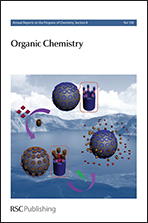Heterocyclic chemistry
Abstract
The main modes of heterocyclic-ring synthesis in 2012 were cycloaddition, multi-component reactions, metathesis and oxidative dehydrogenation and amination reactions with copper, iron, palladium and rhodium being the most widely used transition metal catalysts. There is however a significant number of heterocycles now efficiently prepared in the absence of catalysts. Particularly noteworthy is the utilization of iodine reagents and radical oxidants as effective alternatives.

 Please wait while we load your content...
Please wait while we load your content...